
DISSONANCE, SIMULACRA, AND THE GRAIN OF THE VOICE
ROMAN POLANSKI’S TESS: AN ANALYSIS
John Paul Riquelme
John Paul Riquelme (1946-1922) was Professor of English as Boston University.
Source: John Paul Riquelme, ‘Dissonance, simulacra, and the grain of the voice in Roman Polanski’s Tess’. In Thomas Hardy on Screen, ed. T.R. Wright (Cambridge University Press, 2005) pp. 153-169
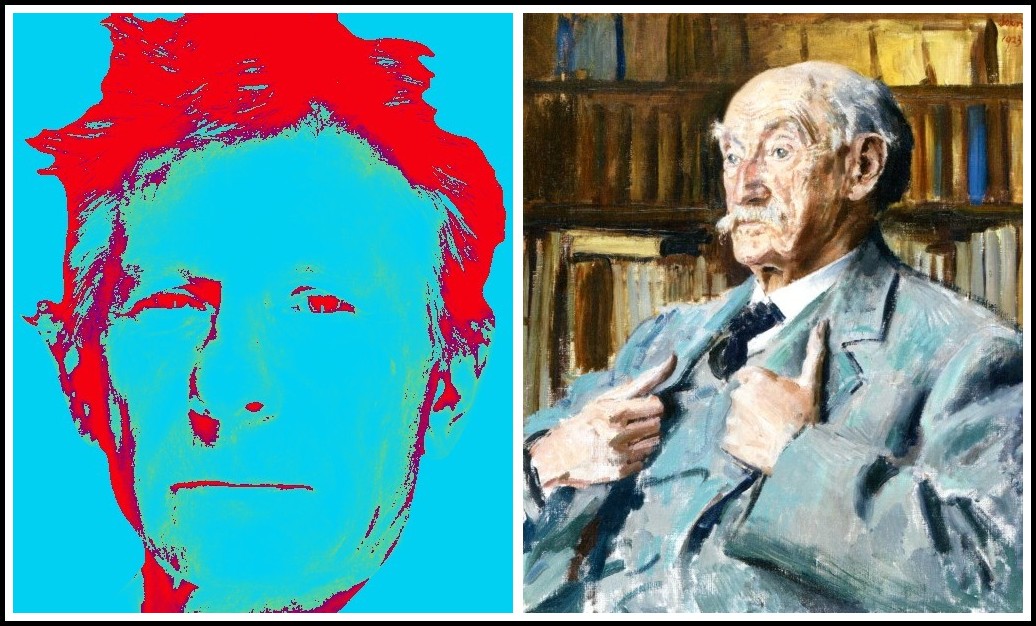
Roman Polanski | Thomas Hardy by Augustus John
I. INTRODUCTION
Thomas Hardy’s Tess of the D’Urbervilles (1891) contains vivid, detailed representations of scene, action, and speech, but it does not fit comfortably into the tradition of realism that Oscar Wilde decries in ‘The Decay of Lying’, which appeared in his Intentions in the same year as Hardy’s novel. In Tess, and generally in his novels from The Mayor of Casterbridge (1886) onwards, Hardy deserves the exemption that Wilde grants to Hardy’s friend and early mentor George Meredith, who, according to Wilde’s Vivian, ‘is not a realist’, but rather ‘a child of realism who is not on speaking terms with his father’.1 In his third-person autobiography, Hardy himself claims that ‘realism’ is not Art’.2 Hardy’s Tess is a book of displacements and dislocations in style as well as narrative. Roman Polanski includes both kinds of dislocation in his film adaptation of the novel, Tess (1979), an adaptation that has sometimes been misunderstood as a realistic work, as has Hardy’s novel.3
1 – Oscar Wilde, ‘The Decay of Lying’, in Isobel Murray (ed.), The Writings of Oscar Wilde, (Oxford University Press, 1989), p.221. I discuss Hardy’s relation to realism in the biographical and historical introduction to my edition of Tess of the D’Urbervilles (Boston and New York: Bedford/St Martin’s, 1998), pp. 9-10 and in the essay ‘Echoic Language, Uncertainty, and Freedom in Tess of the D’Urbervilles’, ibid., pp. 506-20.
2 – Thomas Hardy, The Life and Work of Thomas Hardy, ed. Michael Millgate (Athens: University of Georgia Press, 1985) p. 239.
3 – Virginia Wright Wexman in Roman Polanski (Boston: Twayne Publishers, 1985) pronounces Tess Polanski’s ‘most ‘realistic’ film’ (p.110), though her use of quotation marks around the term is a telling, but unexplained, qualification. Niemeyer, by contrast, emphasises the film’s anti-realism generated by the sound track’s sometimes discordant details (such as the loud ticking of a clock while Tess and Angel sit in silence at table) and by the viewer’s puzzled engagement with enigmatic aspects of the narrative caused by Polanski’s omission of elements in the novel and by Kinski’s impenetrably blank, ambiguous portrayal of Tess (Paul Niemeyer, Seeing Hardy: Film and Television Adaptations of the Fiction of Thomas Hardy (Jefferson, N. C.: McFarland, 2003), pp. 132-43). Niemeyer does not discuss the cinematography. Wexman reduces the implications of Polanski’s use of rack focus to psychological realism (p.114).
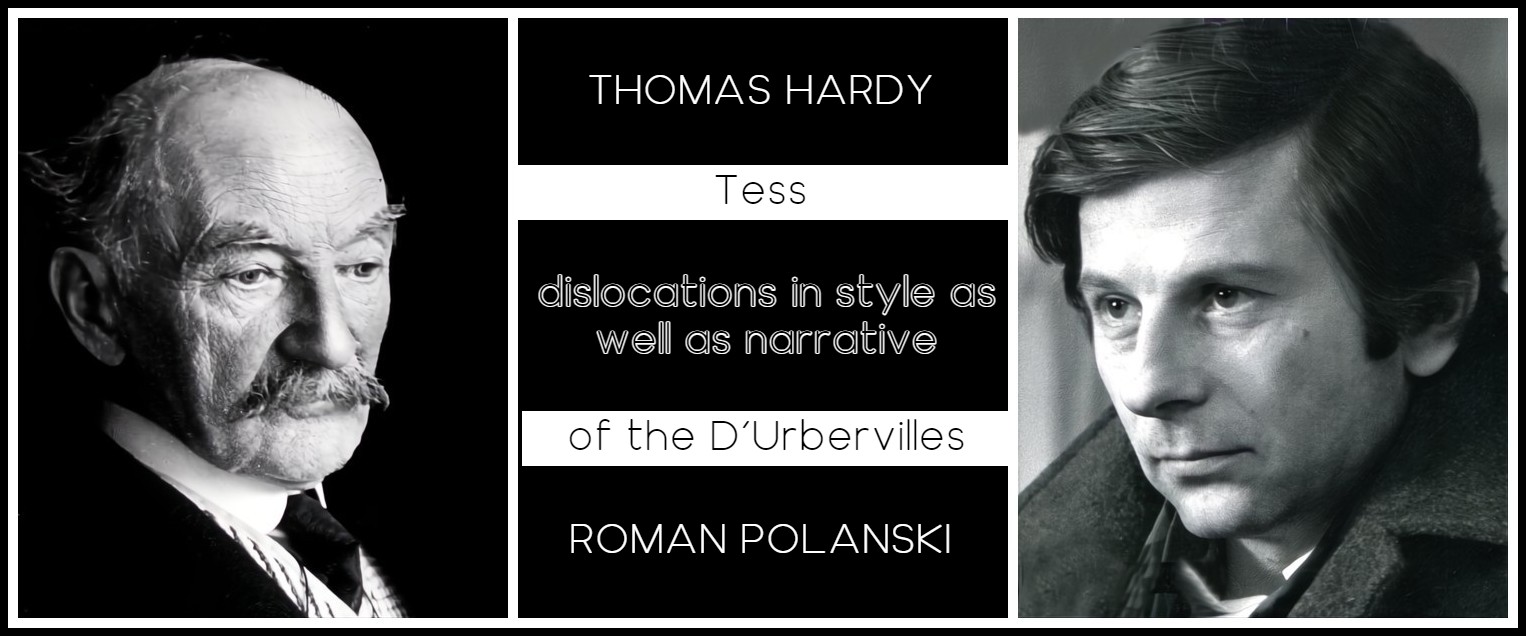
Thomas Hardy | Tess of the D’Urbervilles | Roman Polanski
Extending the assertion by Stendhal’s narrator in The Red and the Black – ‘a novel is a mirror being carried down a highway’1 – we could describe a film with sound as an ‘acoustic mirror’ that travels.2 But Polanski’s acoustic mirror is obviously constituted by a variety of lenses whose recorded images have been edited. Sometimes the editing creates the illusion of realism, the impression of a mirror, a surface that passively reflects. That realistic impression is not the exclusive or even the dominant effect of camera work, editing, spaces, or sound in Polanski’s film. Instead, because of various kinds of dissonance we recognise the world of the film’s narrative as a simulacrum comprised of many component simulacra, large and small. The dissonant and simulacral effects make it difficult for the viewer to forget that what might be understood as a moving mirror is the edited result of work, of camera work and editing, that is, of acts of construction. The effects allow us to perceive what Roland Barthes called ‘the grain of the voice’,3 the process, including the labour, by which the work of art comes into being. That evocation of the grain, which gives us access to the origin of the work of art, takes Polanski’s film beyond realism in a way that expresses Hardy’s modernity as well as Polanski’s, a modernity that has a surprisingly Beckettian tinge.’4
1 – Stendhal, The Red and the Black, trans. Lloyd C. Parks (New York: New American Library, 1970). The statement occurs twice in the novel, first as the epigraph to book 1, chapter thirteen, p. 85, where it is attributed to ‘Saint-Réal’, and later in elaborated form in book 2, chapter nineteen, p. 359.
2 – Kaja Silverman, The Acoustic Mirror (Bloomington: Indiana University Press, 1988)
3 – Roland Barthes, ‘The Grain of the Voice’, in his Image-Music-Text, trans. Stephen Heath (New York: Hill and Wang, 1977), pp. 179-89
4 – I suggest the relevance of Beckett to understanding Hardy’s poetry, especially his late poetry, in my essay on Hardy’s poetic modernity (John Paul Riquelme, ‘The Modernity of Thomas Hardy’s Poetry’, in Dale Kramer (ed.), The Cambridge Companion to Thomas Hardy (Cambridge: Cambridge University Press, 1999), pp. 221-2.
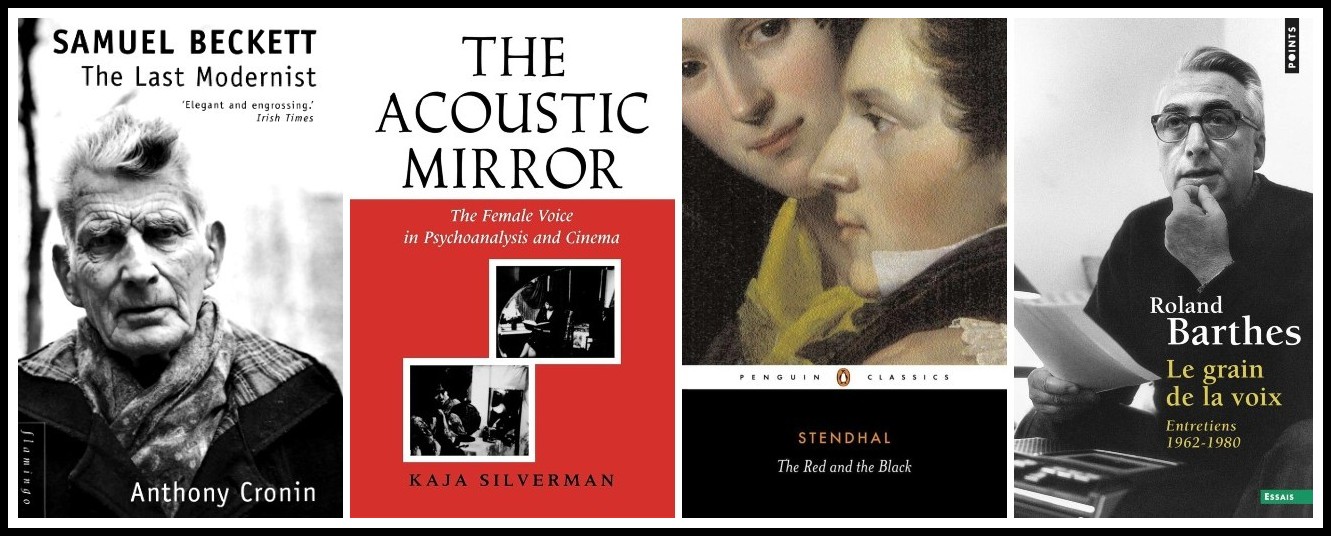
Samuel Beckett | Kaja Silverman | Stendhal | Roland Barthes
A critic would require a more vivid imagination than mine to think, independently of the facts, that a late twentieth-century filmmaker from Eastern Europe, someone who had experienced the Holocaust, modernism and surrealism in the arts, and Beckett, would have the ambition to present faithfully and successfully on the screen the greatest novel of a Victorian novelist, born almost a century before the filmmaker. Fortunately, we are not dependent on the limits of critical imagination concerning Polanski’s Tess, which drew large audiences in Europe and North America and won three academy awards, for cinematography, art direction, and costume design.1 Arguably, the film and its director deserved even more recognition than that. Both the initial acclaim and the subsequent critical attention, which has been scant, may well have been muted because of Polanski’s difficulties with the authorities in California, which resulted in his leaving the United States to work abroad.2 The effect of the scandal deserves comparison with the effect of scandal on Oscar Wilde’s career, though the circumstances were quite different. In both cases, however, the artist under a cloud became for many a taboo subject or a subject of silent scorn.
1 – It was nominated as well for Best Picture, Best Director, and Best Original Musical Score.
2 – Polanski left the US in 1978 to live in France when he was faced with a judicial proceeding on criminal charges having to do with his alleged relationship with an underage girl. In his remarks on the 2004 DVD, Burrill, the British coproducer, describes the difficulties he had in arranging for distribution of the film both in North America and in Britain, despite its success in France. Although he does not attribute the difficulties, which must have arisen from several causes, to Polanski’s personal situation, it is reasonable to assume that some in the movie industry were intentionally refusing to consider his work. Columbia, for example, had dropped Polanski as director for The First Deadly Sins in 1977 after he was arrested. Some critics vilified Polanski when the film was released (see, for example, Jane Marcus, ‘A Tess for Child Molestors’, in Peter Widdowson (ed.), Tess of the D’Urbervilles: Contemporary Critical Essays (Basingstoke: Macmillan, 1993), pp.90-4).
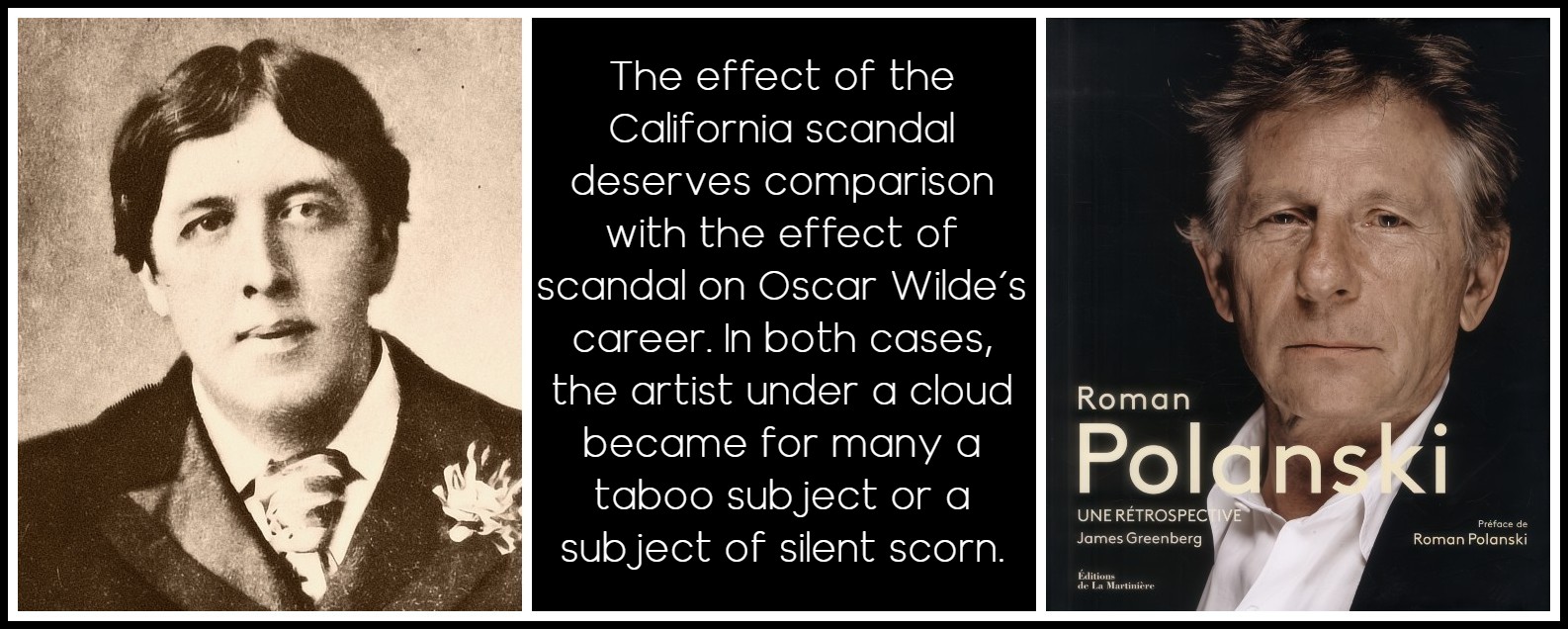
Oscar Wilde | Roman Polanski
Moral issues unquestionably arise concerning the behaviour of both Wilde and Polanski, specifically regarding the responsibilities of older, influential artists towards the young, but silence about their art is implicit censorship by intentional avoidance. Hardy, too, faced restrictive public attitudes reflected in publishers’ requirements when he attempted to publish Tess serially.1 In the cases of both Wilde and Polanski, scandal has contributed to a distortion in the history of the media in which they worked. The history of literary modernism was affected by the critical neglect of Wilde for over half a century, followed in recent decades by a great deal of attention. The recent attention, however, has not resulted in the kind of rethinking of literary modernism’s development that is needed. Nor has the increased attention paid to Polanski since he won an Oscar in 2003 as Best Director for The Pianist made up for the paucity of serious commentary on his work for a quarter of a century.2 The increased interest has, however, given us easier access to his films and more information about them. This is particularly the case with Tess, which was released as a ‘special edition’ DVD in 2004. The DVD contains a documentary by Laurent Bouzereau about the making of Tess, presented in three parts, that includes recent interviews with Polanski and with a number of the other principals involved in the filming.3
1 – See my introduction to Thomas Hardy, Tess of the D’Urbervilles, ed. John Paul Riquelme (Boston and New York: Bedford/St Martin’s, 1998), pp. 11-12. All future references to this novel will be to this text, which reprints the second impression (1920) from the Wessex Edition (1912), the last printing of the novel in which Hardy was involved.
2 – There has been comparatively little written about Polanski’s Tess. John Tibbetts and James Welsh, for example, make no mention of Tess in their Novels into Film (New York: Checkmark Books, 1999), a would-be ‘encyclopedia’ of books made into films.
3 – The seventy-minute documentary is presented as ‘Tess: From Novel to Screen’, ‘Filming Tess’, and ‘Tess: The Experience’. The segments include interviews with Polanski, Claude Berri (producer), Timothy Burrill (co-producer), Nastassja Kinski (Tess), Leigh Lawson (Alec), Anthony Powell (Costume Designer), Pierre Guffroy (Production Designer), John Brownjohn (the British screenwriter), and others. The documentary includes shots taken of the production in progress. During the interview Polanski shows a map of France from the time of the production that marks the route the crew, which he describes as a communal circus troupe, travelled for eight months to locations in Normandy, Brittany, and north of Paris during all the seasons. He and Berri also describe the lengthy editing process that was extended even further when Berri insisted that Polanski shorten the film, which was originally over 3 hours, by 30 minutes. After unsuccessful interventions, by Francis Ford Coppola among others, Polanski himself cut the film to 172 minutes. It is this trimmed version which has been released on VHS and DVD.
Contributing to the comparative silence among critics concerning Tess is the difficulty of rendering discursively its richly paradoxical virtues, virtues that translate Hardy’s arresting changes of register in style and his memorable mixture of realistic and anti-realistic elements into vivid cinematic forms. Both Hardy’s Tess and Polanski’s contain strongly realistic scenes, but the texture of the scenes and their structural relations to other portions of the narrative frequently do not contribute to realistic illusion. In the novel, the anti-realistic elements are evident in Angel’s allegorical name and in the fluctuations of the style from reported dialogue to reported thoughts and to commentary by the narrator that is by turns ironic and learned. The narration regularly breaks the illusion of realism that it also fosters. In considering Polanski’s relationship to realism, it is worth remembering that he had made a strange, at times surrealistic, film, The Tenant (Le locataire, 1976), just prior to filming Tess. The comparatively more realistic texture of his Tess appears to be a turn away from the dominantly expressionistic character of much of his earlier work. But the apparent realism of his Tess is combined, as in Hardy’s novel, with its own apparent opposite, an assault on the limits of realism from within a veneer that invites us to understand it at times in realistic terms as part of a process of overturning the effects and implications of realism.

Repulsion | Roman Polanski | Cul-de-Sac
Both Polanski and Hardy are at odds with realism in a way that amounts to an aesthetic protest against the expectations and limitations imposed on their central character. Observation and protest are no more distinct in their works than they are in Wilde’s ‘The Decay of Lying: An Observation’, which is also a protest. Each develops a stylised mask that enables us to recognise the apparently realistic style for what it is, not a natural perspective but one that has been constructed by cultural processes that are related to the cultural pressures faced by their protagonist. We see through the style and by means of it to a cultural situation in which rigid conventions constrict and deform people in arbitrary, unjustified ways. Society provides a script for the lives of the characters, and it provides a marketable, conventional style, realism, for rendering the narrative in prose and in film. But the script and the style are conventions symptomatic of hierarchies of power that need not be accepted. The writer’s style and the filmmaker’s emerge from the refusal to accept such conventions. In the case of Hardy, we have a late-Victorian writer who contributed with Tess to the first crest of literary modernism, whose experiments in style involve questions of value that are political and moral as well as aesthetic. With Polanski, we have a post-Holocaust, post-surrealist artist attracted to Hardy’s narrative who translates Hardy’s subversions of realism by means of cinematic strategies.
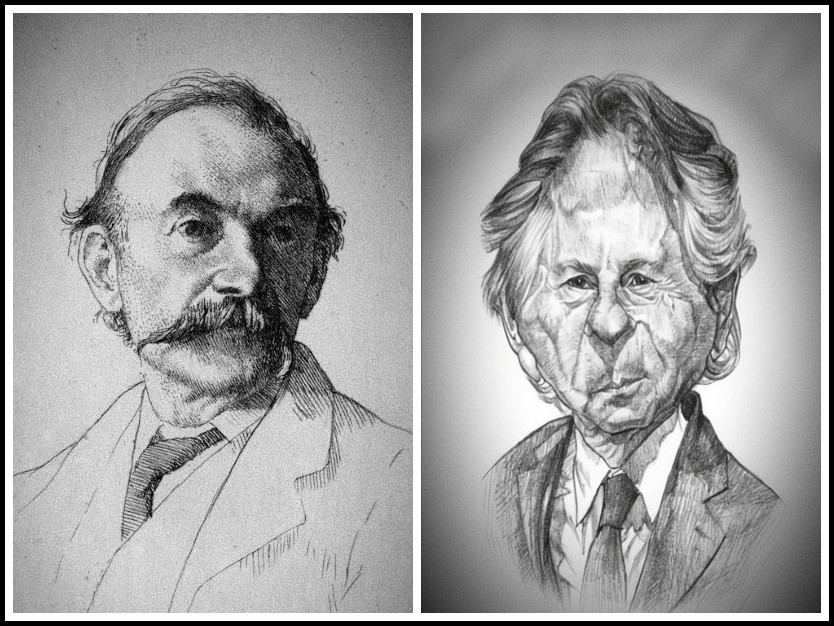
Thomas Hardy by William Strang | Roman Polanski by Sri Priyatham
The motivations and implications for Polanski’s act of recovering Hardy are multiple. They include his evident concern with exploitative social situations in some of his earlier films, including the short works The Fat and the Lean (1961) and Mammals (1962). A central motivation to undertake Tess involves Polanski’s dead wife, the actress Sharon Tate, who was cruelly murdered in 1969 while eight months pregnant. She had left Hardy’s book for him in their bedroom because she was attracted to the role. The film’s dedication, ‘To Sharon’, which appears just below the title, makes clear his association of the work with her. Hardy’s narrative provided Polanski with the opportunity to make a film about a beautiful young woman who dies, but more importantly the woman is not murdered by a man in a senseless act of violence; quite the reverse: the man is murdered in a motivated act by the woman he has damaged, though the act can arguably be called mad. Additionally, the narrative involves flight from the authorities in the wake of the murder, but the flight turns out to be directed into the hands of the police. Escape may have been impossible, but it appears that Tess wishes to be taken, that she has chosen to die by her own hand through committing an act that results in her apprehension and execution; in effect, she is already dead before being apprehended.1 I do not mean to reduce the film to the director’s biographical projections or to draw undue attention to resonances between the film and the life, but it is reasonable to assume that many viewers know about the death of Polanski’s wife and about his own flight from prosecution. In Hardy’s narrative, he found a vehicle for treating again the social effects of power while paying homage to his dead wife; the result aesthetically reverses and rechannels elements of experience that he knew first hand. Polanski makes out of the book, however, not autobiography but dissonant expressionist art that can be mistaken for an exercise in realism.
1 – This interpretation of Tess in both Polanski’s narrative and Hardy’s aligns her implicitly with Wilde’s Salomé, another female victim who takes revenge, apparently knowing that doing so means her own death.
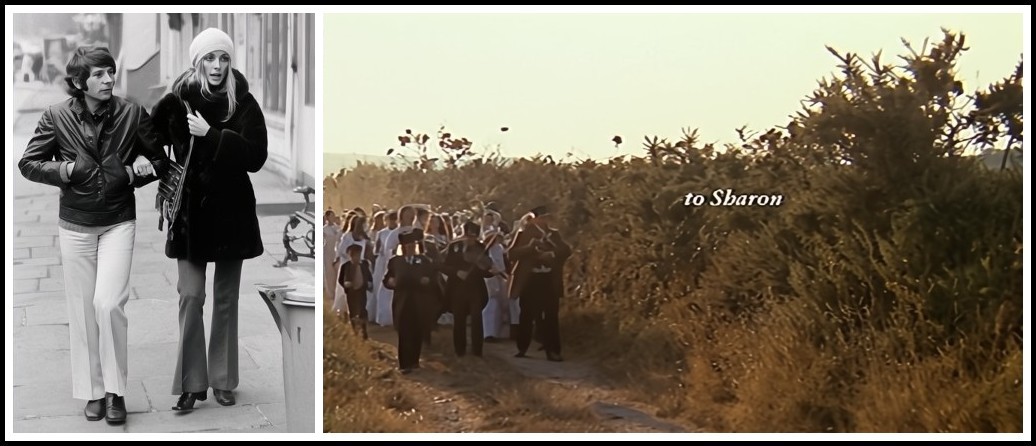
Bill Ray, Roman Polanski & Sharon Tate, 1968 | Roman Polanski, Tess, ‘to Sharon’
II. POLANSKI & BECKETT: TRAMPS, CROSSING THE CHANNEL, FOREIGN ACCENTS
The opening of Polanski’s film presents briefly the ensemble musical procession of the club-walking in which Tess participates as part of the May Day celebration. She is not singled out for the viewer as she later is after the procession has reached its destination, when Angel happens on the dancing and impulsively joins in. As in Hardy’s narrative, the first individualized characters to whom we are introduced are John Durbeyfield (Tess’s father) on foot and Parson Tringham on horseback, who patronisingly tells Durbeyfield about his defunct ancestral line. Unlike the procession with its horizontal movement and engaging music, the scene with the Parson and the one that follows involving Angel and his disparaging brothers project hierarchical relations and class distinctions. These are reflected in the Parson’s elevated position on horseback and in the distance he and then Angel’s brothers dismissively put between themselves and the peasants by literally turning their backs on them and moving away. Hardy glosses the Parson’s elevation and irony in a bitterly ironic way when his narrator returns to the D’Urberville aristocratic past in the book’s closing paragraph. There the narrator evokes the hierarchical world of Greek tragedy by alluding to Aeschylus and the ‘sport’ (T, lix, 384) of the gods, who toy with humans. Not a god but a man of God, the Parson is toying with an uneducated member of the agricultural labouring class, someone whose life is almost beneath his notice.

Tony Church as Parson Tringham | Roman Polanski, Tess | John Collin as John Durbeyfield
The Parson and the ragged peasant inhabit different worlds socially. Durbeyfield in the film, however, occupies a different world from the Parson in a surprising aesthetic way. He does so because Polanski creates a double temporal perspective by bridging Hardy’s late-nineteenth-century English text and post-WWII European perspectives. Rather than linking the English narrative with an ancient Greek dramatist, as Hardy does, Polanski links it implicitly with a post-war dramatist, Samuel Beckett. Polanski makes no attempt to render the novel’s closing passage, with its mention of Aeschylus, choosing instead to conclude the film visually with Tess and Angel’s departure from Stonehenge in police custody. This crucial strategic decision to focus on Stonehenge in the film’s closing is as important as opening with Durbeyfield, as I suggest later.

Samuel Beckett, Waiting for Godot | Roman Polanski, Tess
Durbeyfield’s clothes, his scruffy looks, and his statements now and later in the film qualify him to occupy a conceptual space from which the Parson is excluded: he is a tramp who would fit in on the stage of Waiting for Godot. Durbeyfield is by far the most arresting presence in these early moments of the film. His encounter with the Parson is both true to Hardy’s novel and dissonant, considering the viewer’s post-Beckettian position well past the mid-point of the twentieth century. The dissonant superimposition might seem to be merely circumstantial and coincidental, except that there is substantial evidence of Beckett’s influence on Polanski’s art before and after Tess. That is not surprising considering that Polanski’s career as an actor and director in Europe began just at the moment that Beckett rose to prominence with Waiting for Godot (1952) and Three Novels (1950-3 French; 1955-8 English). Both works were published between the time Polanski started acting in the theatre in the late 1940s and the time he finished his studies at the Lodz Film School a decade later.
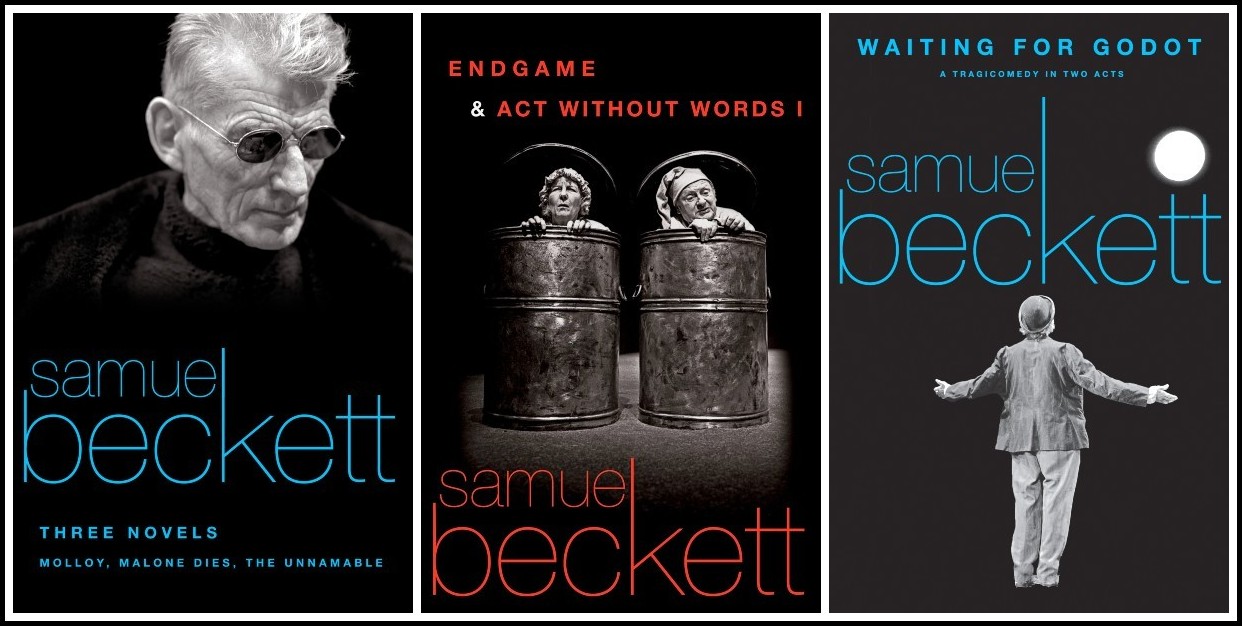
Samuel Beckett | Three Novels, Endgame & Act Without Words I, Waiting for Godot | Grove Press Covers
The short films from the 1960s concerned with the social effects of power that I have already mentioned, The Fat and the Lean and Mammals, were unquestionably influenced by Lucky’s part in Waiting for Godot. In them, the exploitative relations between master and servant are presented by means of a chain used to restrict movement and the pulling of a heavy load. Polanski also cast Jack MacGowan, the Irish stage actor who was a primary interpreter of Beckett, in two of his most successful films, Cul-de-Sac (1966) and Dance of the Vampires (1967). In a prominent French television version of Waiting for Godot directed by Walter Asmus in the year of Beckett’s death (1989), Polanski played Lucky. It is worth remembering that Lucky’s dance in scene two of Godot is called ‘The Net’ and that the dance’s name evokes Aeschylus. Like Agamemnon in the Oresteia and like Tess in Hardy, Lucky is entangled, but his entanglement is part of a staging of being in the net. Although disturbing, Lucky’s performance-within-the-play is not tragic in the mode of Aeschylus, because it is laughable and obviously a matter of performance. Something similar is true of John Durbeyfield as played by John Collin. However well he fulfills within a realistic frame our expectations for the character in Hardy’s narrative, he is also a player in a post-Beckettian staging that, when he is on camera, can be laughable (as in the scene in which he offers to sell the right to his name for ever smaller sums of money, which drop from £1,000 to £20 with hardly a pause for a breath). The laughter, of course, disappears by the time Durbeyfield refuses to allow Tess’s baby to be baptised. We recognise Durbeyfield as contributing to a simulacrum, one that has been produced with painstaking labour to give the look of Hardy’s world. But this world looks back at us and reveals our implication in it because of various dissonances and crossovers that invoke the ostensibly much different world we share with the director.
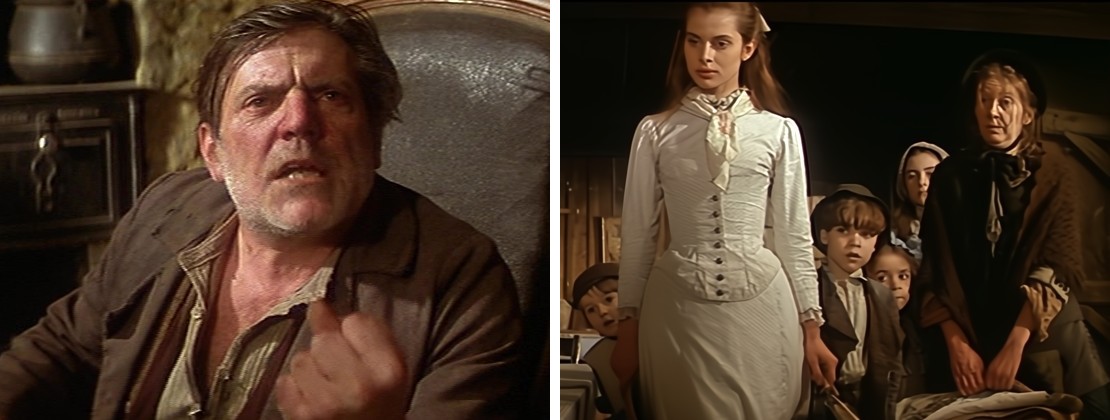
‘Tell him I’ll take a thousand pounds. Well, now I come to think on it, he can have it for a hundred.
I won’t stand on trifles. Fifty. Twenty pounds, tell him, and not a penny less. Family honour is family honour.’
The crossovers include many aspects of the production and its result. The most evident of these for the viewer is the casting of a German actress as Tess. Nastassja Kinski, however, is only one element in an international artistic situation of Beckettian proportions, especially in the crossover between French and English. As with Beckett’s work, which he often self-translated between English and French, it is impossible to characterise Polanski’s Tess as anything but a hybrid, an anomalous result that emerges through the interaction of elements that are often kept separate. It is a French film by a Polish filmmaker, first released in France, but made jointly through French and British collaboration, that represents English locales using locations and a studio in France and that stars a German actress portraying an English country girl. The agricultural action on the land set in England would seem to be far removed from the experience of a Polish filmmaker, but in fact after leaving Cracow as a child to escape Nazi persecution, Polanski lived in the Polish countryside, where he learned about agricultural life, including how to milk cows. The type of farming he encountered in Poland must have been much closer to the sort presented in Hardy’s novel than the more modern agricultural techniques that had already become established by 1900 in England and in Western Europe.
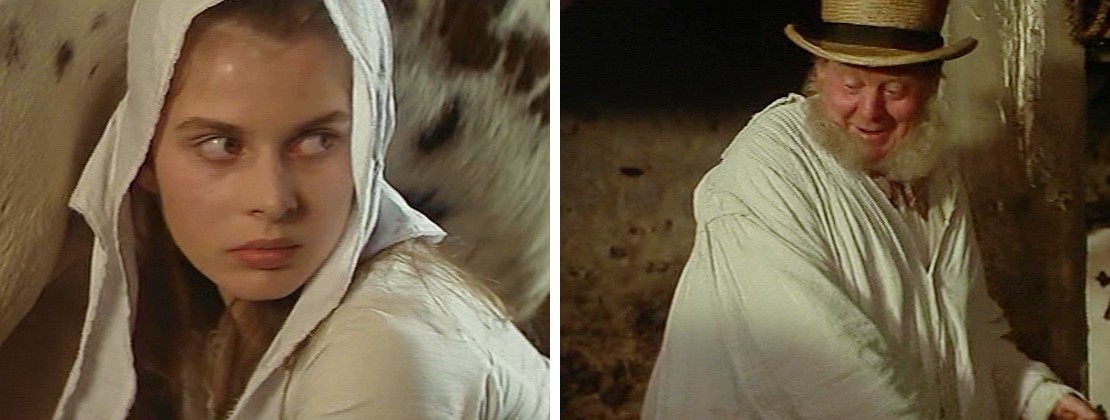
Nastassja Kinski as Tess | Roman Polanski, Tess | Fred Bryant as Dairyman Crick
The production company was a joint venture, a Franco-British co-production between Renn Productions in France and Burrill in England. Although based on Hardy’s English, the first version of the screenplay was written in French by Polanski and his long-time screenwriting partner, Gerard Brach. In order to put the screenplay in its ultimate form, however, John Brownjohn, an English writer from Dorset, joined the team and helped invent English dialogue for scenes in which Hardy had provided none. These scenes are of particular interest in the film because of their central placement and distinctive camera work, as I suggest below. The cinematography was initially the responsibility of Geoffrey Unsworth, the famous British cinematographer, but Unsworth died while the film was still being shot. He was replaced by Ghislain Cloquet, a French cinematographer, who simulated Unsworth’s style for the remainder of the shooting. Costumes were designed by Anthony Powell, who is British, but he worked, necessarily, in collaboration with Pierre Guffroy, the French production designer, and Jack Strange, the British art director. The film’s three academy awards, then, went jointly to a British and a French cinematographer, jointly to the British art director and the French production designer, and to the British costume designer.
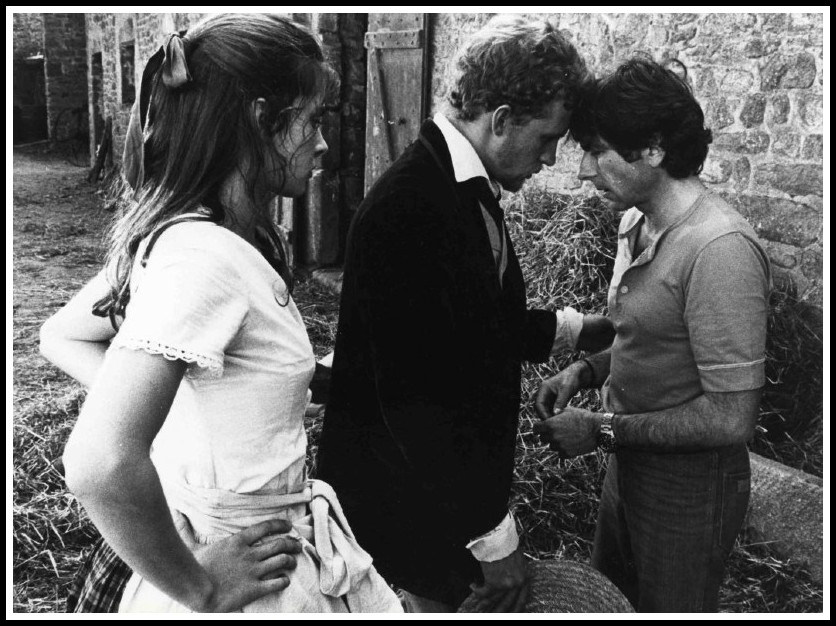
Shooting Tess: Nastassja Kinski, Peter Firth, Roman Polanski
It is easy to imagine someone dismissing the boundary-crossing that characterises the film’s production as aesthetically insignificant for viewers, as simply one of those oddities of the modern world. But culturally and aesthetically the boundary crossing is no more irrelevant than Beckett’s situation in-between with regard to France and Ireland, the French language and the English language. The implications concerning the mixed national character of the artist’s working methods and context have an aesthetic dimension with regard to language for both Polanski and Beckett, well beyond the quandary that French bookshops and libraries face when they try to identify these artists as French or as foreign. Their language is pervasively inflected in ways that militate against our reducing their works to responses appropriate to realistic art emerging from a single national origin. The perceptible, unavoidable trace of the heterogeneous origins of Polanski’s Tess is evident whenever Nastassja Kinski speaks as Tess.
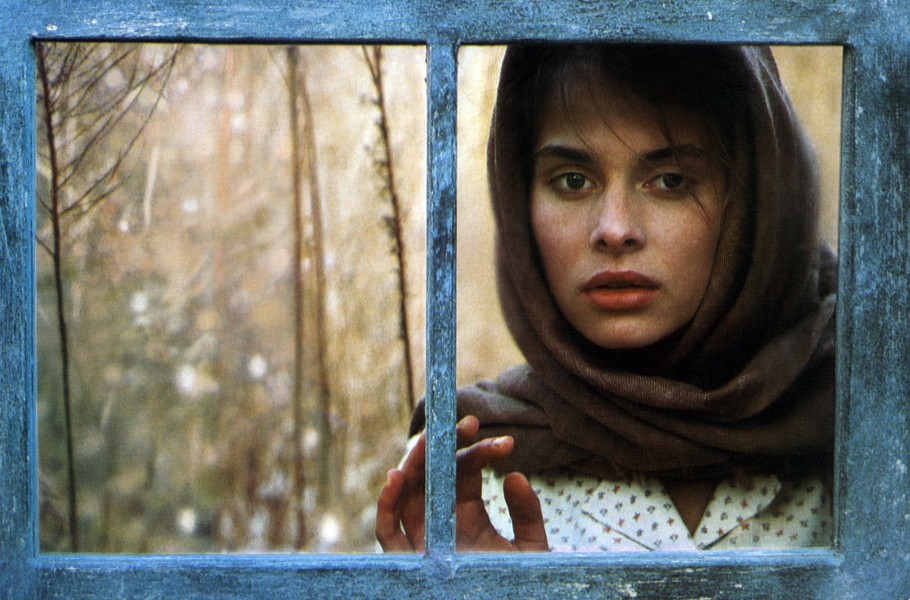
Nastassja Kinski, Tess, Roman Polanski
When I first saw Tess in the cinema twenty-five years ago, I disliked it intensely because my realistic expectations for the film were disappointed by what I heard and saw. My reaction was so strong that I left at the intermission. My main disappointment concerned the casting of Kinski in the lead. I probably could have accepted the delicacy of her features and her ethereal looks (in comparison with the other country girls), but I could not accept her voice. Kinski’s English was without doubt fluent, but every word she spoke made it evident that she was a European actress playing a young rural woman from the south of England. Rather than being a flaw in the movie, however, her spoken performance is a brilliantly dissonant feature, one that makes it impossible for the spectator to mistake Tess for realism. The bold, unconventional casting of Kinski is comparable to Oscar Wilde’s decision to cast Sarah Bernhardt as the first Salomé in the production that the English censor refused to license. Bernhardt at the time was in her forties, while her character was a nubile teenager. Both casting decisions have the effect of keeping the audience off balance through a refusal to fulfil expectations concerning details that are essential for realistic portrayal: age and voice.

Nastassia Kinski, Tess, Roman Polanski
That refusal puts Wilde’s projected staging of his own play and Polanski’s cinematic response to Hardy in an aesthetic space that Samuel Beckett identifies in ‘Three Dialogues’ as beyond ‘the plane of the feasible’.1 He means that the work of art cannot be mistaken for something that we have encountered before and have learned to accept as if it were natural and inevitable. Our spoken language is never natural, though we tend to behave as though it were. In Hardy’s narrative, Tess herself asserts the often suppressed difference between the socially constructed and the natural when she says to Angel, ‘I am only a peasant by position, not by nature!’ (T, xxxv, 236). When a language is spoken with foreign inflections, even slight ones, its learned quality becomes perceptible to the listener, as does the physical, material process by which our vocal cords produce the apparently natural sounds of the languages that we acquire. Polanski’s film as acoustic mirror respeaks Hardy’s English and his narrative with a European accent and reflects a landscape that is not English, whose features are and are not real.
1 – Samuel Beckett, Proust and Three Dialogues with Georges Duthuit (London: John Calder, 1987), p. 103
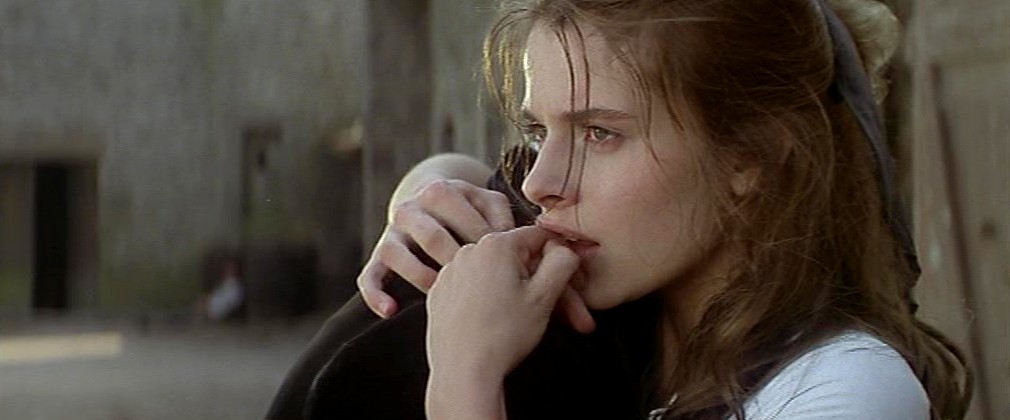
Nastassja Kinski, Tess, Roman Polanski
III. ECHOES, MIRRORS, AND SHIFTING FOCUS
Respeaking someone else’s language is the work of the mythological figure Echo, whose story is entangled with the story of Narcissus, in which water acting as a mirror plays a central part. Hardy’s narrative of Tess’s life is a version of the tale of Echo and Narcissus, but Narcissus is doubled for her, since both Angel and Alec are egotistical. In the classical myth, Narcissus dies by wasting away in a kind of slow suicide. Angel comes close to experiencing that kind of self-destruction because of his wrong-headed relocation alone to Brazil. Tess becomes a vengeful Echo when she murders Alec. Twice in Hardy’s narrative, Tess respeaks Angel’s words. In chapter forty-six, she contributes to the undoing of Alec’s religious conversion by repeating an argument to him that she has learned from Angel (T, xlvi, 315). When she and Angel are parting just before he goes to Brazil, she literally repeats his words in their conversation, and the narrator emphasises the repetition by pointing out that ‘She simply repeated after him his own words’ (T, xxxvii, 254). As director and as collaborator on the screenplay, Polanski also plays an echoic role by enabling the repetition of Hardy’s language through a translation first into French. As part of the echoic translation, he reproduces Tess’s echoing of Angel by retaining her repetition in the conversation before they part.
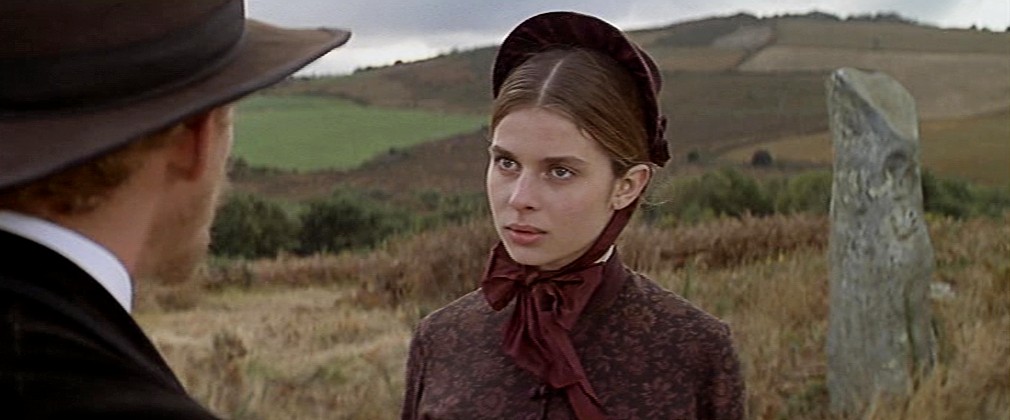
Nastassja Kinski, Tess, Roman Polanski
Polanski also makes changes in Hardy’s narrative, mostly excisions, such as the dropping of Angel’s sleepwalking. But there are also additions and shifts in emphasis, notably ones that give Tess more to say and that emphasise her acts of writing. Together with Tess’s letter-writing, her confession to Angel, which Polanski renders in detail even though Hardy does not, adds to our sense of her strength of will. The elaborated confession scene in the film and the scenes that immediately precede and follow it constitute a significant, centrally placed sequence not only in the screenplay but in the camera work. Tess’s confession is literally in the centre of the film; as it is divided into scenes on the 2004 DVD, the scene is fourteenth of twenty-eight. In his use of both a shallow space and rack focus, Polanski brings the film’s expressionistic tendencies sharply to the fore.1
1 – The association of shallow space and rack focus with expressionism and of deep focus with realism is widely accepted in film studies. See James Monaco, How to Read a Film (Oxford: Oxford University Press, 2000), p.86. Christian Metz, The Imaginary Signifier: Psychoanalysis and the Cinema (Bloomington: Indiana University Press, 1982) informs my own discussion of cinematic mirroring and voyeurism.
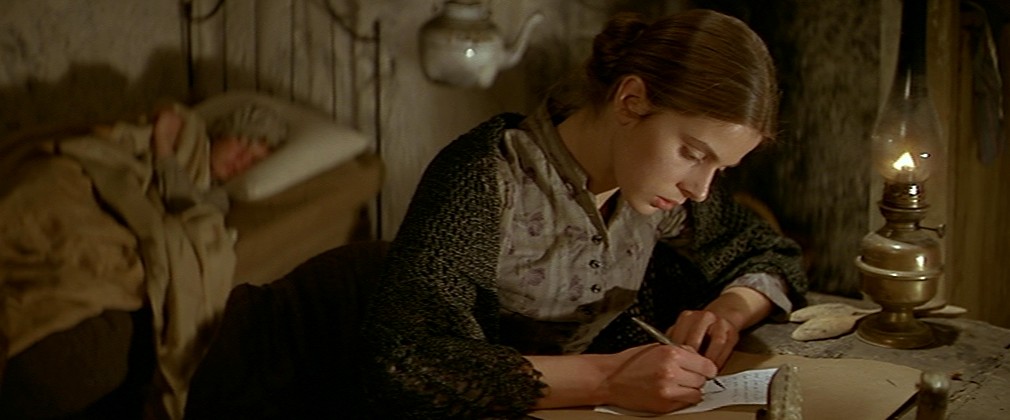
Nastassja Kinski, Tess, Roman Polanski
The prelude to the confession includes shots of action not in Hardy’s narrative in which Angel and Tess stand directly in front of a mirror washing their hands together and expressing their sense that their hands have become indistinguishable. The space is shallow, because the mirror hangs against a wall. But the mirror transforms the shallow space into a deeper one reflecting the room behind them. The effect is a visual illusion accompanying the characters’ illusion, or delusion, about love that they voice sentimentally in terms that viewers are likely to find unconvincing. We may see through, as well as by means of, this visual illusion involving a mirror. In other shots Polanski’s use of mirrors is more complex. For example, in the scenes involving the milking of cows in Dairyman Crick’s barn, Polanski uses a wall-sized mirror at the end of the barn to enlarge its dimensions visually. The mirror in the barn, however, is only perceptible in a still, not while the frames are in motion. The mirror in the handwashing scene can have quite a different effect, primarily because the reflection is unaccountably not in crisp focus and because it does not reflect us. We are observing the characters, seeing them and their profiles reflected in the mirror, but we are also looking directly into the mirror. This is an anomalous situation in the experiencing of a cinematic image that is supposedly to be understood as real. A real mirror would reflect us, but this one, of course, does not. The film, represented by the mirror we look at but not exactly into, looks back at us blankly and expresses the film’s generation of visual illusions by suppressing our reflection.

Nastassia Kinski & Peter Firth, Tess, Roman Polanski
The mirror in the middle of the shot in which we see the reflections of others but not ourselves is reminiscent of Las Meninas (1656) by Velazquez, in which the mirror against the back wall of the salon reflects the images of the King and Queen of Spain, who are the subjects of the painting that Velazquez depicts himself as producing. The couple are also the spectators of the scene, as are we, but we are not reflected in the mirror. The connection might seem far-fetched, but Velazquez’s painting and Polanski’s out-of-focus mirror scene have in common a play on the singular and the doubled, the visible and the obscured, the illusion and the act of construction, the angle of vision and the manipulation of visual elements. Angel asks Tess whose hands are whose in the basin, and she replies that they are all one, specifically that they are all his. While they are having this exchange about two being one, the viewer is having a visual experience that gives rise to a recognition that the scene includes a doubling of action in the represented space that is reflected in the mirror and a simultaneous recognition that what we see in the mirror and the words we hear from the acoustic mirror of the film are constituted by illusion. Failing to see ourselves doubled by the mirror, we recognise the mechanism that generates realistic illusion, rather than accepting the illusion as if it were natural.
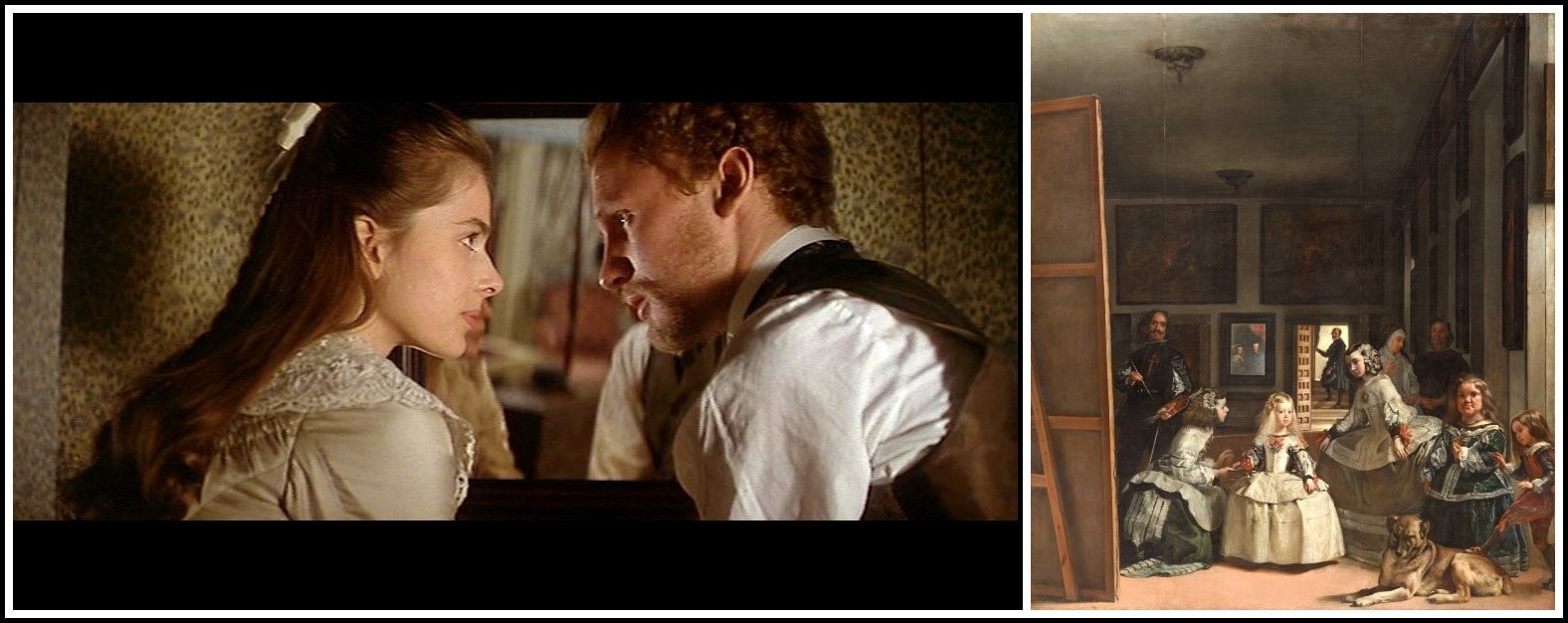
Roman Polanski, Tess, 1979 | Diego Velásquez, Las Meninas, 1656
Velazquez employs the geometry of the various planes in the represented space of his painting in ways that disturb the realistic illusion for the viewer, who is then likely to consider the dynamics of the handling of space within the painting. To that extent, we participate in the artist’s act of construction and recognise its immanent position within the represented space. Something similar emerges during the scene in which Tess confesses, shortly after the scene with the mirror, when Polanski uses rack focus, that is, a change in focus during the scene, to disturb our relation to the ostensibly realistic space. The changes in focus can remind us that the mirror in the earlier scene was, strangely, not quite in focus. Tess may well think of herself and Angel as one, but she also insists on parity with him when she refuses to let him ignore her determination to confess after he has. As soon as she begins to speak, Angel, who starts out standing, while Tess sits down, goes mildly out of focus. As she continues, he goes further out of focus and sits down, which creates the opportunity for the camera to present him as if he were in a lower space.

Nastassja Kinski & Peter Firth, Tess, Roman Polanski
The focus changes several times between the two characters, until finally the scene ends with Angel walking out of focus deeper and deeper into the space of the rooms, through two doorways until he is out of sight. The camera work is memorably effective in displacing the realism of deep focus (which presents the whole of a scene’s action in sharp focus) by the expressionism of shifting focus. Deep focus is usually taken to contribute to the impression of realism because the camera work does not draw attention to itself. Our eye is supposedly free to roam where it will. Rack focus, by contrast, makes the effects of lenses and angles insistently evident. It is as though Tess’s insistence on attention is matched by the director’s camera. Rack focus often shifts our attention from one character or object in a scene to another, but as Polanski uses it multiply during the confession, the redirecting of our vision is ambiguous, aleatory, and potentially quite active. We are as likely to be drawn to the character in sharp focus as we are to the character who is out of focus. Or we might be looking back and forth between them in an energetically shifting way that resembles the effect of the ambiguous geometry of Las Meninas on the eye. The shifting intensifies the oscillation of the spectator’s wandering vision created by the multiple changes in focus. As with Kinski’s out-of-tune English voice, the in-and-out-of-focus, ambiguously directive camera work makes us aware of the process by which the work has been created.

Nastassja Kinski & Peter Firth, Tess, Roman Polanski
In the next scene, during the conversation between Tess and Angel about their situation, Polanski changes Hardy’s dialogue by having Tess repeat in echoic fashion Angel’s words about her being a different woman now. This repetition, which prepares for the echoic speech at their parting, is followed by Tess’s impassioned statement that she was a child when Alec seduced her.

Nastassja Kinski & Peter Firth, Tess, Roman Polanski
By the time the second act of repetition occurs, at the parting, Tess has accepted Angel’s decision to live separately from her. But her glancing away from Angel during the second echoing and the measured character of the repetition indicate that Tess’s passion and determination, exhibited in the earlier scenes, have not been extinguished. They are merely being held temporarily in check.

Nastassja Kinski & Peter Firth, Tess, Roman Polanski
The scene much earlier between Tess and Alec, in which he insists that she allow him to put a strawberry in her mouth, provides a figure for understanding Tess’s relation to Echo. For a time, she reluctantly accepts having things put in her mouth, strawberries and words, but ultimately she, like the German actress who plays her, has a voice of her own, and a will that refuses to accept.

Nastassia Kinski, Tess, Roman Polanski
The refusal comes out visually in Sandbourne near the movie’s conclusion in the scene that precedes Tess’s taking her revenge on Alec. That scene sends us back to Tess’s determination to confess and to tell her own story because the camera work again involves prominent use of rack focus. Tess’s agitated will to act and to speak parallels the camera work’s energetic, paradoxical expressive movements. As with the earlier scene involving the mirror, the position of the observer contributes to breaking the illusion. We initially observe the scene between Tess and Alec from outside the room through the keyhole with the landlady, but in mid-scene the viewing direction is abruptly reversed. We now look from inside the room directly towards the door behind which the landlady peeps as Tess walks towards it, inadvertently scaring the observer away. In effect, the change of direction asks us to look at our own obscured point of vantage, at our participation in the act of looking and our engagement with the scene.

Leigh Lawson & Nastassja Kinski, Tess, Roman Polanski
As Angel did earlier, Alec first stands and then sits, but Tess goes blurrily out of focus with her head on the table. When she stands, however, and the direction of observation is reversed, she is silent but in focus while Alec, now gone fuzzy, continues to speak words that are not in Hardy’s narrative. Hardy’s Tess reports that Alec called Angel ‘by a foul name’ (T, lvii, 372), but we witness Polanski’s Tess experiencing Alec’s attempt to put words in her mouth by suggesting an answer for his question about why she is upset. No longer willing to be ventriloquised, this now silent Echo acts.

Leigh Lawson & Nastassja Kinski, Tess, Roman Polanski
IV. BOOTS, SIMULACRA, AND THE WORK OF ART’S CONTRADICTORY ORIGIN
The dissonance in Polanski’s film is a matter of contradictions, including especially ones that involve the spectator’s eyes and ears. The dissonance emerges as well through the linking of apparently incommensurate aspects of human experience in Hardy’s narrative. Polanski replicates that linking in a way that enables the viewer to recognise the constructed quality of the human world by experiencing the act of aesthetic construction in the grain of the voice and in simulacra. Polanski expresses the humanly created quality of our world by labour inscribed in the film’s techniques and by representations of labour, but also by the prominence he gives to non-representational constructions. We see the contrasting elements, representations of labour and the centrality of non-representational creations, in quite different moments of Hardy’s narrative that Polanski retained. These include the scene involving Mercy Chant’s taking of Tess’s boots (at the conclusion of Tess’s thwarted attempt to visit Angel’s parents in Emminster) and the closing scene at Stonehenge.

Roman Polanski, Tess
These contrasting scenes, one set in an agricultural village and the other set on Salisbury plain, contain elements that Martin Heidegger uses to evoke the character and the origin of the work of art in his seminal essay, ‘The Origin of the Work of Art’.1 Heidegger discusses first Vincent van Gogh’s representation (in more than one painting) of an agricultural worker’s well-worn boots and then a temple, specifically a Greek temple. Like Stonehenge, another temple, the Greek temple is an architectural work of art that is not utilitarian or instrumental in the ordinary sense because it is not a tool, not a means to achieving a practical end. Van Gogh’s painting, by contrast, presents objects that are utilitarian in character, though his painting, while representational, is, like the temple, not utilitarian. As Heidegger explains, the temple ‘cannot be ranked as a representational art’: ‘A building, a Greek temple, portrays nothing. It simply stands there in the middle of the rock-cleft valley’.2 His essay throws light on the contradictory mix that Polanski recognises in Hardy and reproduces, because Heidegger attempts to bridge by juxtaposition the difference (without reducing or effacing it) between the utilitarian, representational vector and the non-representational vector in the dynamic of the work of art. Any attempt to understand art, he implies, and, in effect, to understand what it means to be human, will attend to these apparently incommensurate realities of art.
1 – First delivered as a lecture in 1935, then published in a revised form in 1950, Heidegger’s essay was republished with final revisions and a 1956 Addendum in 1960.
2 – Martin Heidegger, ‘The Origin of the Work of Art’, in his Basic Writings, ed. David Farrell Krell (New York: Harper and Row, 1977), pp.149-87 (p.168).
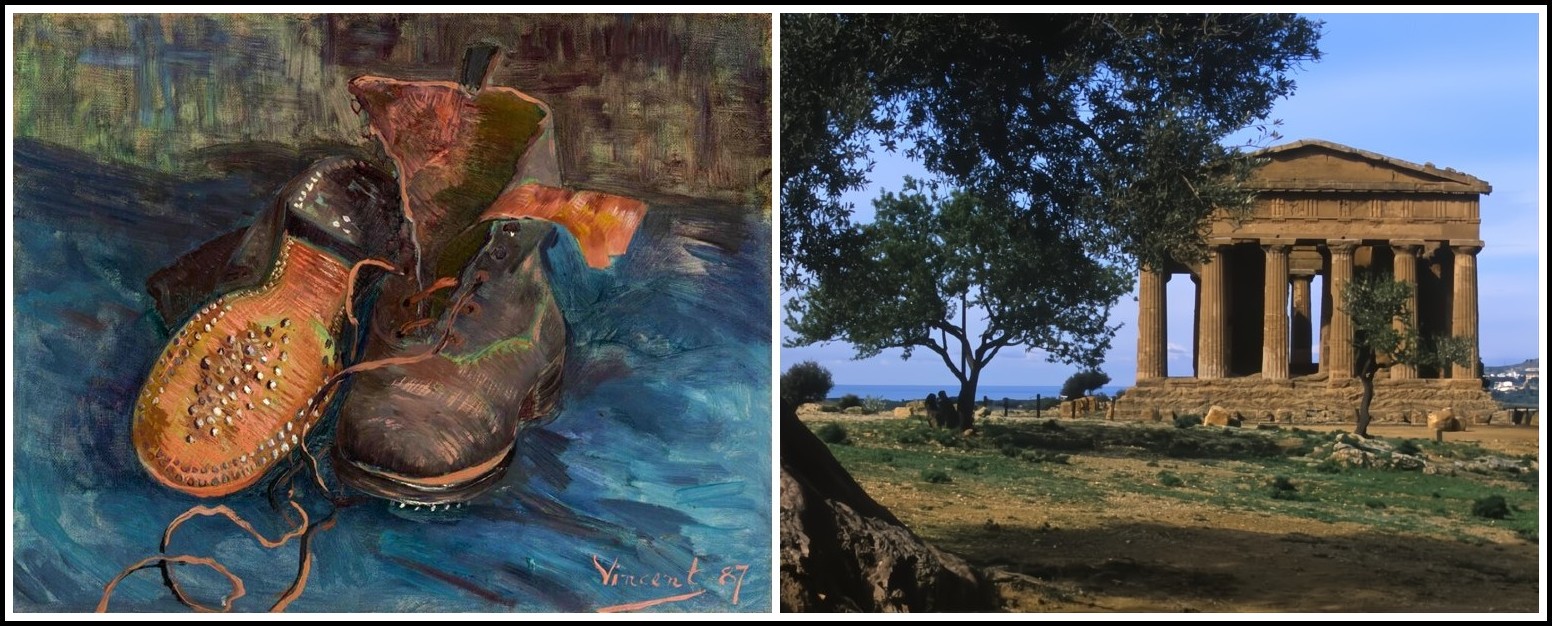
Vincent van Gogh, A Pair of Boots, 1887 | ‘Temple of Concordia’, Agrigento, Italy
Polanski’s Tess renders cinematically the distance, the dissonance, and the mutually defining relevance of these contrasting realities. His Tess is able to occupy the spaces appropriate to both the utilitarian world of representational art and the non-representational space of the temple. She is equally at home and equally out of place in both spaces. Following Hardy, Polanski creates for us the surprising, unlikely linkage. A shorthand way to make that point is to repeat what the novel tells us repeatedly, that Tess is both Durbeyfield and D’Urberville, an assertion that Polanski realises in a creative process that crosses over between English and French. He also evokes the duality when Tess inhabits film spaces that would seem to belong to quite different films. Tess walks into and out of both scenes, but she is presented as if a different person in each. In the earlier one, she is solitary and, though dressed in her best clothes, obviously a woman who lives on the land. In the later one, she is accompanied and dressed in the fashion of the city, a fashion that marks her as urban. In the earlier scene, her boots are taken into custody by Mercy Chant, while Tess walks out of the village in a different direction.

Roman Polanski, Tess
In the later scene, it is Tess who is taken into custody.

Nastassia Kinski, Tess, Roman Polanski
The shots in the earlier scene give us first a view of Tess from behind walking out of the village space, then a contrasting shot of Mercy’s back as she walks away at the same moment with Tess’s boots.

Roman Polanski, Tess
Without transition, Polanski cuts to Alec on horseback riding directly towards the camera. We know that he is headed towards Tess. By contrast, in the closing scene, the police on horseback move towards Tess, but they do so in a slow, steady motion that puts Tess under arrest and takes her up into a final movement out of the scene. The pace and the aggressive shifts into and out of the village space, with the virtual ejection of Tess while an important part of her is confiscated, have been displaced by a contrasting continuity of movement that has the feel of a cortège.

Roman Polanski, Tess
The most remarkable contrast, however, concerns the setting of the two scenes. The village, like the boots, is representable as intelligible and utilitarian. It is a space for living and working on what Beckett refers to as the ‘plane of the feasible’, though Tess finds no comfort there. The space could easily have been the context for a more realistic presentation of the action, had Polanski not edited the shots in such an exaggerated way. Stonehenge as temple, however, is both non-representational and a simulacrum of a non-representational structure. As a full-scale model of Stonehenge in a form similar to the original as Hardy knew it, Polanski’s simulated Stonehenge, like the mirror earlier, stands paradoxically for the film itself in its genuine-seeming but obviously anti-realistic appearance. The viewer is likely to realise that this is and is not Stonehenge, which has been in a significantly greater state of ruin for many decades. Even twenty-five years ago it had become a protected space that would not have been available as a movie set and would not have been suitable for the scene because of its state of decay. A shot from the filming in Bouzereau’s documentary shows Polanski looking at and adjusting a small model of the simulated Stonehenge, as if it were a toy, which, in fact, it is. The diminutive, simulated quality of the small model is also an aspect of the full-scale simulation. The simulacral effect resembles that of one of Alexander Calder’s steel stabiles that mimic the monumental buildings also made of steel that tower over them; it turns the space into the space of human creation, despite the monumental, threatening surroundings, through an act of doubling, a repetition with a difference.

Roman Polanski, Tess
At the end of Hardy’s novel, his narrator famously evokes the situation of humans as the playthings of the gods. But his own narrative combines the antithetical aspects of the work of art that Heidegger implies enable us to recognise ourselves not as playthings but as human agents who play and create in a double contradictory situation. Having meditated on the utilitarian, referential aspect of art and on its equal, opposite, and connected non-representational aspect, Heidegger suggests that we encounter in art its ‘createdness’,1 its having come into being. The created, generating quality that we encounter is the grain of the voice. We recognise and experience our engagement with the act of creation in Nastassja Kinski’s voice, in Roman Polanski’s expressionist camera work, in boots that Vincent van Gogh painted and that Tess Durbeyfield walks in and then away from, and in the simulacrum of a temple as the film’s dissonant, contradictory, genuinely illusory space. Our directions through that space take us not only to Tess’s death but to recognitions of ourselves in the shifting, dissonant echoes and reflections of an acoustic mirror.
1 – Martin Heidegger, ‘The Origin of the Work of Art’, in his Basic Writings, ed. David Farrell Krell (New York: Harper and Row, 1977), p. 181

Roman Polanski, 1968 (Photo: Bill Ray) | Thomas Hardy, c. 1890 (Photo: Mansell/Life)
T.R. WRIGHT: THREE BOOKS
CLICK ON THE IMAGE TO GO TO A DESCRIPTION OF THE BOOK
MARA, MARIETTA: A LOVE STORY IN 77 BEDROOMS – READ THE FIRST CHAPTER
A literary novel by Richard Jonathan
RICHARD JONATHAN, MARA, MARIETTA: A LOVE STORY IN 77 BEDROOMS – READ THE FIRST CHAPTER
AMAZON & APPLE BOOKS
RICHARD JONATHAN, ‘MARA, MARIETTA: A LOVE STORY IN 77 BEDROOMS’ | AMAZON PAPERBACK OR KINDLE
RICHARD JONATHAN, ‘MARA, MARIETTA: A LOVE STORY IN 77 BEDROOMS’ | APPLE iBOOK
MARA, MARIETTA: A LOVE STORY IN 77 BEDROOMS
A literary novel by Richard Jonathan
RELATED POSTS IN THE MARA MARIETTA CULTURE BLOG
CLICK ON THE IMAGE TO GO TO THE CORRESPONDING PAGE
By Richard Jonathan | © Mara Marietta Culture Blog, 2024 | All rights reserved
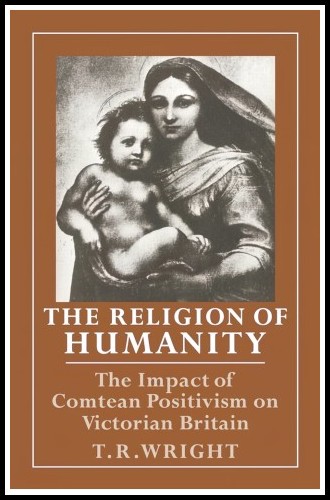
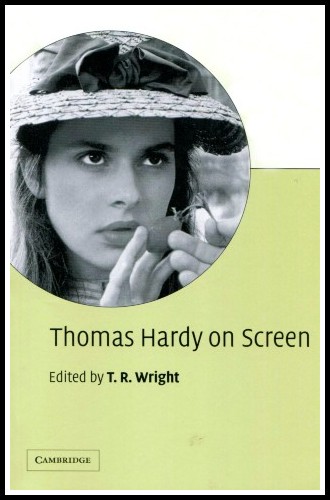
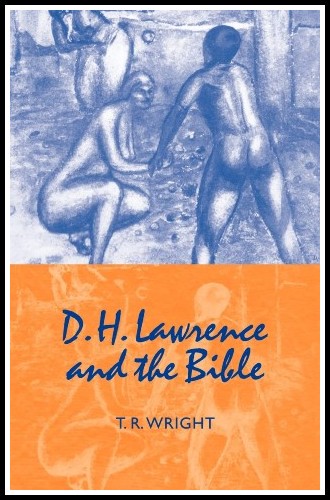
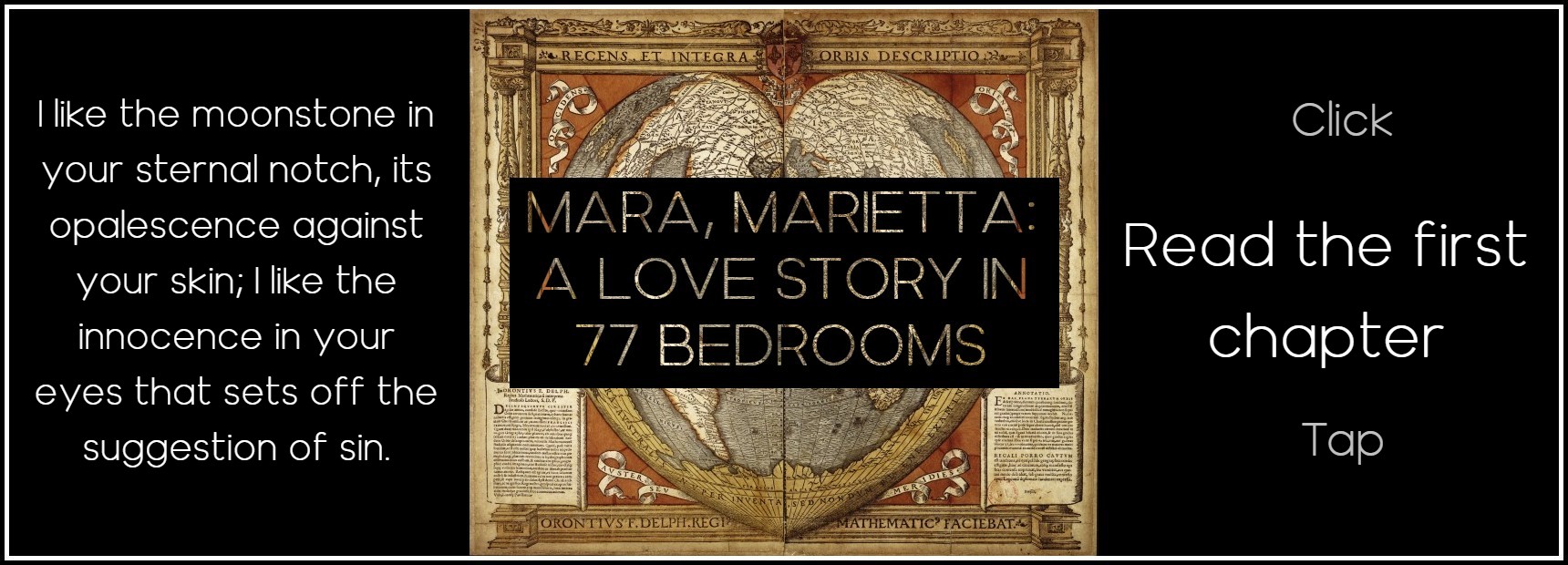








Comments